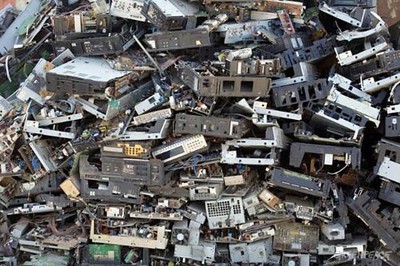Abstract
If you made a pile of all the electronic devices (cell phones, computers, stereos, televisions, MP3 players, video game systems, remote-control toys, etc.) that your family has gotten rid of since you were a baby, how big would that pile be? Would it be taller than you? Would it fit better in a wheelbarrow or in a pickup truck? And did they just throw it in the trash? In this science project, you'll explore what people in your community do with electronic waste, commonly called e-waste, and whether or not those actions are environmentally friendly.Summary
Sandra Slutz, PhD, Science Buddies

Objective
Examine how people deal with e-waste, and which electronic devices, if any, are most likely to be recycled.
Introduction
How many of your friends have cell phones? How about computers, video game consoles, or MP3 players? What happens to all those electronic devices when they break, or someone gets a new, cooler version? This is a question that many scientists and economists around the world are asking. They want to know "What are people doing with their e-waste?". E-waste, short for "electronic waste," is a growing international problem because so much of it is generated every year. According to estimates from the Environmental Protection Agency (EPA), in 2005, between 1.9 and 2.2 million tons of electronic waste was disposed of in the United States alone. That's the weight equivalent of approximately 1 million cars! Where does all this waste go? The vast majority of it (about 80 percent, as of 2005, according to the EPA) ends up in landfills, while a smaller percentage is recycled. The estimates are that the total quantity of e-waste will continue to climb as electronics become more and more affordable, and part of the worldwide collective culture.
 Image Credit: Greenpeace/ Natalie Behring-Chisholm / http://www.greenpeace.org/international/en/Help/copyright2/
Image Credit: Greenpeace/ Natalie Behring-Chisholm / http://www.greenpeace.org/international/en/Help/copyright2/
Figure 1. A pile of electronic waste on a roadside in Guiyu, China gives an idea of the sheer volume of e-waste generated worldwide. (©Greenpeace/ Natalie Behring-Chisholm, n.d.)
Why do scientists and economists care about e-waste? Because disposing of it has challenges and raises many questions:
- The most obvious challenge is space. Can we physically accommodate all this e-waste in landfills? If so, is it a good idea or not? And if not, where do we put it?
- Another issue is resources. By weight, most of an electrical device is made from inexpensive, abundant resources, like silica (often found in sand) and plastic. But some of the circuitry has small amounts of precious metals, like platinum, gold, and silver, or very rare and expensive materials like indium and gallium. Does it make economic sense to just throw away these more expensive or rare materials? If we do, will there be a shortage of the rarer ones? How cost-effective is it to extract those materials from e-waste?
- The third major issue is about pollution and health hazards. Some of the substances used in electronic devices can be toxic, like the cadmium and lead found in many circuit boards, or the mercury often present in flat-screen monitors and switches. When they're enclosed in their proper places within a device, these toxic materials are harmless, but what about a broken monitor or circuit board that gets buried in a landfill? Do the toxic substances leach into the soil and water table of landfills, or are they contained? How safe is it for workers to dismantle these electronics and recycle the components?
In this science project, you'll collect your own data and draw your own conclusions about e-waste. First, do some background reading about e-waste. The Bibliography can help you get started. Then decide for yourself what you think are the best ways to deal with e-waste, and which methods are the most environmentally friendly. Once you've sorted that out, you'll survey people in your community to find out what they do with e-waste. Do they create a lot of it or not? Do they throw it in the trash, recycle it, reuse it, or just store it in their garages indefinitely? Your findings might help your local officials decide how to deal with e-waste!
Terms and Concepts
- E-waste
- Leach
- Water table
- Bias
- Percent
- Pie chart
- Bar chart
Questions
- What are the ways to dispose of an electronic device? How do those methods compare, environmentally?
- How much e-waste is generated nationally? Internationally?
- What kinds of toxic substances are found in e-waste? What are the health hazards associated with them?
- Which substances in e-waste could be valuable? Is it cost-effective to extract them?
Bibliography
- Environmental Protection Agency. (2008, July). Fact Sheet: Management of Electronic Waste in the United States. Retrieved August 8, 2010.
- ewasteguide.info. (n.d.). Valuable Substances in e-waste. Retrieved August 8, 2010.
- Greenpeace. (2010). What is E-waste?. Retrieved August 8, 2010.
- Symantec. (2009, March 11). How to Recycle Computers, Keyboards, and More. Retrieved August 8, 2010.
- United Nations Environment Programme. (n.d.). E-waste Management: Overview. Retrieved August 8, 2010.
Materials and Equipment
- Computer, paper, and printer to create surveys
- People to distribute the survey to (minimum of 10 households; see the Experimental Procedure for details)
- Lab notebook
Experimental Procedure
Working with Human Test Subjects
There are special considerations when designing an experiment involving human subjects. Fairs affiliated with Regeneron International Science and Engineering Fair (ISEF) often require an Informed Consent Form (permission sheet) for every participant who is questioned. Consult the rules and regulations of the science fair that you are entering, prior to performing experiments or surveys. Please refer to the Science Buddies documents Projects Involving Human Subjects and Scientific Review Committee for additional important requirements. If you are working with minors, you must get advance permission from the children's parents or guardians (and teachers if you are performing the test while they are in school) to make sure that it is all right for the children to participate in the science fair project. Here are suggested guidelines for obtaining permission for working with minors:
- Write a clear description of your science fair project, what you are studying, and what you hope to learn. Include how the child will be tested. Include a paragraph where you get a parent's or guardian's and/or teacher's signature.
- Print out as many copies as you need for each child you will be surveying.
- Pass out the permission sheet to the children or to the teachers of the children to give to the parents. You must have permission for all the children in order to be able to use them as test subjects.
Creating and Distributing Your Data-collection Survey
- In order to collect data from each household about how much e-waste they generate and how they dispose of it, you'll need to create a data-collection survey. The next couple of steps will help you decide what to include in your survey. For more advice about creating good surveys, read the Science Buddies guide to Designing a Survey.
- Decide which electronic devices you'd like to include in your survey. Here are a few possibilities to get you started: computers, televisions, cell phones, stereos, mp3 players, video game consoles, handheld video game machines, electronic toys, printers, fax machines, computer monitors.
- Create a table, showing all of the devices and the various ways to dispose of them. Table 1 lists five possible outcomes for an electronic device, but you might be able to think of more.
| Type of Electronic Device | # of Devices Disposed of and/or Replaced in the last 3 Years | What happened to each device? | ||||
| # Thrown Away | # Reused | # Recycled | # Stored | # Unsure | ||
| Cell phone | ||||||
| Television | ||||||
| Computer | ||||||
| Table 1. You can include a table like this one in your survey for the participants to fill out. | ||||||
-
Write a set of instructions asking the members of the household to please fill in the table.
- You might want to instruct them to all sit down together and fill out the form together to decrease the likelihood that people report an item more than once by accident.
-
Define what each of the disposal scenarios means. For example:
- Thrown away: put in the normal garbage.
- Reused: given/sold to another person or charity for them to use, or taken apart in order to use some parts of it for another purpose.
- Recycled: returned to manufacturer for recycling or brought to an e-waste recycling center.
- Stored: sitting unused in a closet, garage, storage unit, or other location waiting for someone to do something about it.
- Unsure: don't remember how it was disposed of.
- It is a good idea to have someone read through your instructions and see if they are clear and easy to follow before you print your final version of the survey.
-
You can customize this science project any way you want! There might be additional questions you want to focus on and thus, additional data you need to collect using your survey. Read the Analyzing the Survey Data and Variations sections, before making the final version of your survey. Remember to:
- First, decide what your questions are. For example, "How long do people use each type of electrical device before disposing of it?"
- Second, come up with a hypothesis for each question based on your background reading, such as "On average, households will use a cell phone for two years before disposing of it, but use a television for 10 years before disposing of it."
- Third, list all the data you'll need to evaluate each hypothesis. For example, the amount of time each electrical device was used before it was disposed of.
- Fourth, check and make sure that your survey questions will result in answers for all the data on your list. For instance, you'd need to add a column to the table asking people to list approximately how long they'd owned each electronic device prior to disposing of it.
-
Using your survey, collect data from at least 10 households. A household includes all the people, related or not, who live together in a house or apartment. The more households you survey, the more representative of the typical household your data is likely to be. For a more complete explanation, see the Science Buddies guide to
sample size.
- People you may be able to collect data from include: classmates, friends, parents' co-workers, extended family members, and neighbors.
- Avoid collecting data from households that have experienced major property damage from a catastrophic event, like a fire, flood, or tornado, within the past five years. These households might have had to dispose of and replace an unusually large number of electronic devices in a short period of time, thus skewing the results.
- Once you've decided from how many households you are going to collect data, print out as many copies of the survey as you'll need and distribute them. Make sure you also have a plan for when and how you'll collect the completed surveys.
Analyzing the Survey Data
The data you collect can be analyzed in many different ways. A few ways are described below, but you should continue to explore other questions and perform your own analyses. Some questions and hypotheses you think of might require you to collect additional data, so design your survey accordingly. Below are three questions you could explore and how to do so.
-
Across the households you surveyed, what is a typical household's most common method of disposing of an electronic device?
- For the first household, add up the number of devices that were disposed of in each manner. Record the data in a table, like Table 2 below, in your lab notebook.
- Repeat this for each household.
-
At this point, you could sum (add up) the number of devices in each disposal category across all households, but some households might dispose of more electronic devices than others. To eliminate this bias in the data, convert your data into percentages.
- For the first household, sum the total number of electronic devices disposed of. Divide the number of electronic devices "thrown away" by the total number of devices disposed. Multiply by 100 to convert this into a percentage. Repeat the calculation for the other disposal methods.
- Repeat for all households.
- For each disposal method, average the percentages across all households. Create a pie chart to show your results. Which disposal method is the most common? Which is the least common?
| Household | Total # of electronic devices disposed of: | Method of disposal for all electronic devices: | |||||||||
| Thrown Away | Reused | Recycled | Stored | Unsure | |||||||
| # | % | # | % | # | % | # | % | # | % | ||
| 1 | |||||||||||
| 2 | |||||||||||
| Table 2. A table like this is useful for looking at how each household disposes of e-waste, independent of the type of electronic device. | |||||||||||
-
Across the households you surveyed, what is the most likely fate of each electronic device?
- Take the first electronic device listed in your survey. Let's use "cell phone" as an example. Create a data table, like Table 3 below, showing how many cell phones were disposed of in each household in each manner.
-
For each disposal method, sum (add) the number of cell phones across all households.
- For example, add the number of cell phones "thrown away" in household # 1 to the number of cell phones "thrown away" in households 2, 3, 4, and so on.
- Repeat for all disposal methods.
- Note: In step 1.c. of this section, the question was about the typical disposal methods of a household; for this reason, you had to be careful to not have any one household skew, or bias, the results. However, in this current cell phone example, the question is about what is the most likely fate of an individual cell phone. The fact that some households might dispose of more cell phones is relevant in this analysis. It is not a bias in this case and should not be removed.
-
Convert the sums into percentages.
- For example, take the sum of cell phones that were "thrown away" and divide by the total number of cell phones disposed of using all the methods. Multiply by 100 to convert to percentages.
- Create a pie chart to visualize the results for cell phone disposal.
- Repeat the process for all the other electronic devices on your survey.
| Household | Total # of Cell Phones Disposed of: | Method of cell phone disposal: | |||||||||
| Thrown Away | Reused | Recycled | Stored | Unsure | |||||||
| # | % | # | % | # | % | # | % | # | % | ||
| 1 | |||||||||||
| 2 | |||||||||||
| Sum of all households | |||||||||||
| Table 3. Creating a table for each type of device, like this one for a cell phone, allows you to focus on the data for just one type of electronic at a time. | |||||||||||
-
Which devices are most likely to be recycled? Which are least likely to be recycled?
- Using the data from step 2, make a bar chart with the percentage of devices recycled on the y-axis and each type of electronic device on the x-axis. There should be one bar for each electronic device.
Ask an Expert
Global Connections
The United Nations Sustainable Development Goals (UNSDGs) are a blueprint to achieve a better and more sustainable future for all.
Variations
- How does e-waste compare in different countries? If you have a pen pal, friend, or family member who lives in a different country, see if he or she would be willing to distribute your survey there. Compare the results from different countries. Do households in the various countries dispose of different quantities of electronic devices? Do they dispose of them in different ways?
- Do the household members' attitudes toward recycling or "being green" correlate with specific e-waste disposal methods? Include questions on the survey to determine people's attitudes toward recycling. When analyzing the data, read about correlation statistics and use those to interpret your findings.
- Using the data collected and information from your background reading, can you figure out a way to create an e-waste rating for each of the households you surveyed? Which households were most environmentally responsible? Which were the least environmentally responsible? Why?
- Examine the e-waste habits of local businesses, rather than households.
- Can you find any reliable statistics about e-waste? If so, how do those statistics match up with your survey results?
Careers
If you like this project, you might enjoy exploring these related careers:
Related Links
- Science Fair Project Guide
- Other Ideas Like This
- Environmental Science Project Ideas
- My Favorites
- Designing a Survey
- Sample Size: How Many Participants Do I Need?










